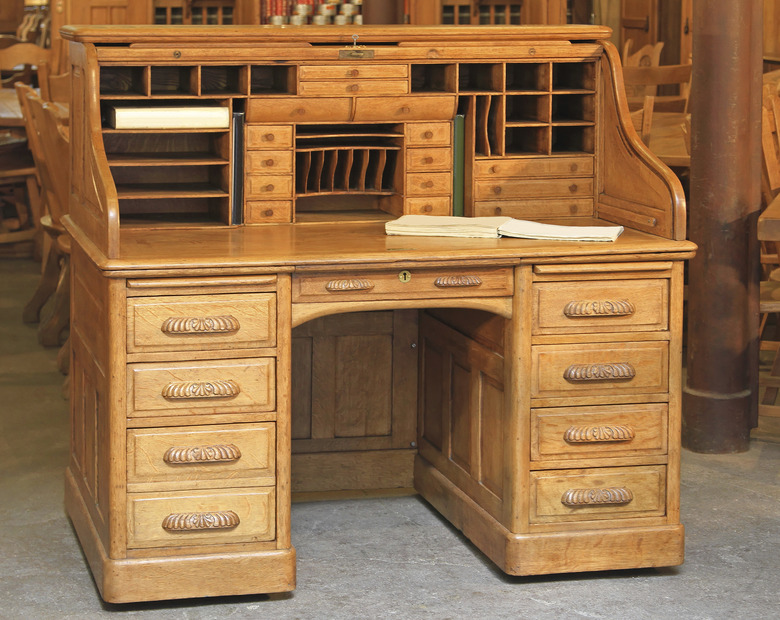How To Determine The Age Of An Antique Roll-Top Desk
We may receive a commission on purchases made from links.
Roll-top desks first appeared in the United States during the latter part of the 19th century. Each desk featured a rolling door that slid up and down to reveal or conceal built-in pigeonholes, shelves, and a flat writing surface. The exterior facade of a roll-top desk as well as its construction can provide visual clues as to its age. Trustworthy resources can help confirm your age calculations.
Signs of an Older Roll-Top Desk
- Made of cherry, mahogany, or walnut wood
- Hand-cut dovetail joints
- Manufacturer's stamp on lock
- Heavy wear and tear and natural distress
Signs of a Newer Roll-Top Desk
- Made of oak wood
- Machine-cut dovetail joints
- No manufacturer's stamp
- Minimal wear and tear and intentional distress
Identify the Wood
Identify the Wood
Take a good look at the type of wood the roll-top desk is made of to help you determine its age. The early roll-top desks were typically constructed from cherry, mahogany or black walnut, while oak was often used after 1900. Mahogany is strong and dense because it lacks knots and holes in the grain of the wood, while cherry has a distinctive reddish appearance. Solid black walnut has a natural dark brown hue with attractive grains. Oak is easy to distinguish from mahogany, cherry or black walnut due to its golden-toned lighter hue.
Examine the Joints
Examine the Joints
Remove a drawer from the roll-top desk to see how it was put together. A dovetail joint resembles the triangle shape of a bird's tail and holds the boards together with cutouts in the wood that fit together snugly. Unlike the earliest dovetail joints, which were irregular because they were cut by hand, the machine-cut dovetail joints were precisely created by machines for a refined look. Look closely for irregular saw cuts or a rough appearance, indicating the desk was likely an early roll-top desk, possibly built prior to 1890. A precise, identical joints suggest a mass-produced desk, probably constructed a few years before 1900 or later.
Check for Wear and Tear
Check for Wear and Tear
Check the desk for original locks stamped with a turn-of-the-century manufacturer's name, such as Derby Desk Company, Schlicht Area Company, Shannon File Company, or Cutler Desk Company. You might also find the name of the manufacturer underneath the desk, which could even include the date the piece was manufactured. Newer roll-top desks or pieces manufactured to mimic authentic antiques typically have no manufacturer or date markings.
Roll-top desks that have been in use for over a century have obvious signs of wear-and-tear, such as bumps, scratches, nicks, and patina discoloration. However, reproductions are often artificially distressed to appear older than they really are. Examine a distressed desk for repetitive or intentional distressing patterns, which are good indications the piece is not a genuine antique.
Look to Professional Resources
Look to Professional Resources
Use credible resources for help with accurate dating of a roll-top desk — for example, certified appraisers, antique dealers, and furniture experts. If you purchase an antique desk from an estate sale or an individual, inquire about its history from family members or the estate sale company. Antique furniture guides, books, and magazines can also provide a wealth of valuable information and pictures to help you pinpoint the age of your roll-top desk.
